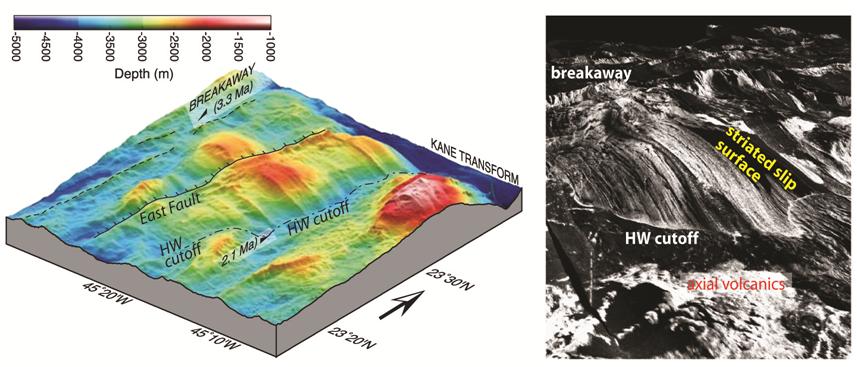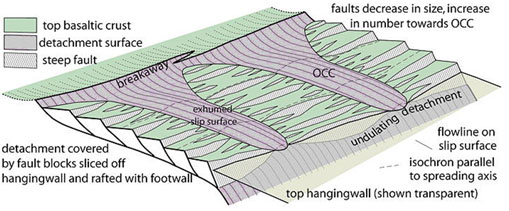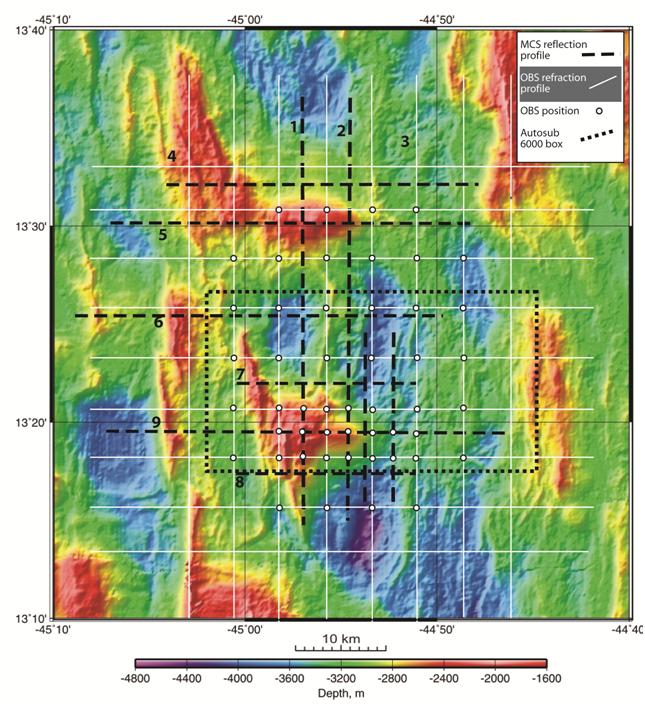Two-thirds of the Earth’s surface is paved by oceanic crust formed by seafloor spreading at the 60,000km-long global mid-ocean ridge (MOR) system. As the rigid ocean plates are pulled apart, at rates varying from <10 to 160 mm/year, the Earth’s mantle is drawn up from beneath, partly melting as it does so. The melt separates from the mantle and rises to the surface to form a continuous layer of 'magmatic' crust, typically about 6km thick, made of basalt at the surface and gabbro, its slowly cooled equivalent, beneath.
Oceanic detachments and a new paradigm for slow seafloor spreading
However, over the past 15 years we have come to realise that, at spreading rates below about 40 mm/yr, this simple model cannot be incorrect. Instead, large tracts of mantle rocks may be exposed on the seafloor, with no magmatic crust being present. Plate separation on slow-spreading MORs such as the Mid-Atlantic Ridge (MAR) may instead be taken up in part on great dislocations – unusually large geological faults known as ‘detachments’ – on which tens of km of extension may be accommodated. Where exposed on the seafloor these faults typically form flat or gently domed surfaces on which mantle rocks and/or gabbro are exposed. These structures are known as ‘oceanic core complexes’. We think OCCs form when the magma supply dwindles and seawater is able to penetrate down a fault and access mantle rocks beneath. These rocks, called 'peridotites', are made mostly of the mineral olivine, which reacts easily with water to produce the weak minerals serpentine and talc, lubricating the fault and allowing it to continue slipping and develop into a long-lived detachment.
Very recently, several workers (including Birmingham PI Reston) have proposed that detachment faulting is far more common than previously supposed, to the extent that up to half of all Atlantic seafloor may be generated by such ‘tectonic’ spreading. They view detachments as regionally continuous features that underlie all the seafloor on one side of the ridge axis, but only emerge at the surface in a few places, the OCCs (see figure below).
Key Questions
But is detachment faulting really so widespread? From a detailed study of the 13°N region of the MAR, Co-Is MacLeod (Cardiff) and Searle (Durham) came to the quite different, and much less extreme, view that detachments are discontinuous and restricted to individual OCCs. They are interspersed between volcanically active, magma-rich ridge segments, and triggered by localised waning of magma supply. In this model detachments are episodically 'killed' by renewed magmatism, often delivered laterally from adjoining segments.
How can we distinguish these very different hypotheses about the mechanism of seafloor spreading? The key data needed are: (1) the sub-surface geometry and extent of the detachments beneath the ridge axis, (2) the amount and detailed distribution of magmatic crust, and (3) the asymmetry of spreading rates associated with OCCs and volcanic seafloor (they should be similar in the regional and differ in the local detachment models).
Research cruise James Cook 132
During a cruise from 13 January to 24 February 2016, leaving from Mindelo in the Cape Verde Islands and finishing in Port of Spain, Trinidad, we obtained new data in a comprehensive seismic and seabed magnetic survey of the MAR in the 13°N region, where detachment faults are active at the ridge axis today. We used a large array of ocean-bottom seismometers (OBSs – run by Co-I Peirce - Durham) to image 3D velocity variations related to different rock types using 'seismic tomography' – akin to medical CT scanning – and conduct a multichannel reflection survey, which image sub-surface discontinuities – like a simple X-ray. We used a longer deployment of the OBSs to record the locations of natural microearthquakes in the region. These show directly the 3D geometry and linkage of active faults. Finally, we deployed the autonomous robot vehicle Autosub 6000, which was programmed to make very detailed maps of magnetic field reversals (yielding seafloor age and spreading rate) and seafloor topography (helping structural interpretations).
The project is a collaborative project with Durham (wide-angle seismic and magnetism), Cardiff (bathymetry), Woods Hole and Paris. The main cruise is scheduled to take place from 13 January to 24 February 2016, leaving from Mindelo in the Cape Verde Islands and finishing in Port of Spain, Trinidad.
Birmingham participation in the cruise will be Tim Reston (chief scientist), Murray Hoggett and Gael Lymer.

Figure 1: perspective view of the two oceanic core complexes (OCCs). Left the Kane B OCC (Canales et al., G3, 2008), marked by clear corrugations parallel to the Kane transform fault; right the 1320 OCC, the target of the research project (MacLeod et al., EPSL, 2009).

Figure 2: perspective view showing how OCCs might just be the part the exposed parts of a more laterally continuous detachment surface which elsewhere is covered by small fault blocks sliced off the hangingwall and rafted out of the median valley (after Reston and Ranero, 2011).

Figure 3: map of the study area showing the proposed layout of the seismic reflection and refraction data including the location of ocean bottom seismometers. The dashed line shows the approximate extent of Autosub investigations. Autosub is an unmanned robotic submarine called an autonomous underwater vehicle (AUV) which will collect near seafloor bathymetry, imagery and magnetic data during the cruise.
Secondary school teacher Angela Bentley will be taking part in the Cruise and blogging about it.
Follow Angela on Twitter
Find out more about the expedition
Members of staff involved:
Tim Reston (PI), 1 PDRA tba
Project funding:
NERC. Birmingham budget: £513,738 (£410,990 from NERC)
Publications:
Relevant to the project but not from project funds:
Reston TJ and McDermott K. 2011. Successive detachment faults and mantle unroofing at magma-poor rifted margins. Geology, 39, 1071-1074
Reston TJ and Ranero CR. 3D geometry of detachment faulting at mid-ocean ridges. Geochemistry, Geophysics, Geosystems, vol. 12, Number 7, Q0AG05, doi:10.1029/2011GC003666.
Planert L, Flueh ER, Tilmann F, Grevemeyer I, Reston T (2010),Crustal structure of a rifted oceanic core complex and its conjugate side at the MAR at 5°S: implications for melt extraction during detachment faulting and core complex formation, Geophys. J. Int., 14p., DOI: 10.1111/j.1365-246X.2010.04504.x
Planert L, Flueh E, Reston, TJ., 2009. Along and across-axis variations in crustal thickness and structure at the Mid-Atlantic Ridge at 5° South obtained from wide-angle seismic tomography: Implications for ridge-segmentation. J. Geophys. Research, 114, B09102, doi:10.1029/2008JB006103
Key periods of data collection/fieldwork activity:
Awaiting cruise scheduling